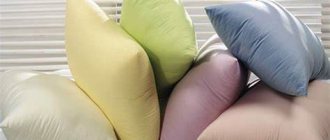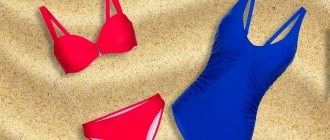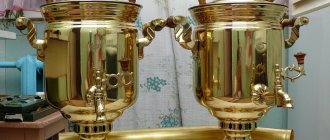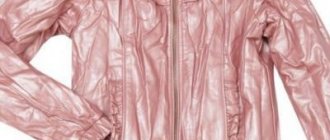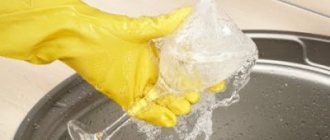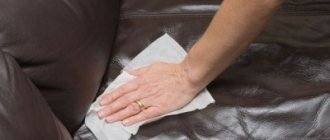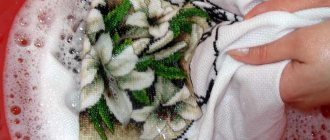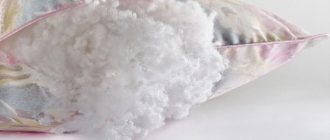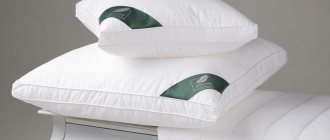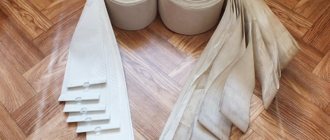Sound sleep is the key to good health. One of the factors for a comfortable sleep is a comfortable, soft and clean pillow. The classic version of pillow filling is feathers.
This natural material is quite demanding in terms of how to care for it, but it will adequately reward all efforts made with a long service life, thermal insulation properties, and ergonomic shape.
Read the article about how to wash feather pillows at home without ruining them.
Is it possible to do this?
The recommended frequency of washing pillows is twice a year. Frequent water procedures adversely affect the condition of the filler, worsening its quality.
Before you start the washing process, it is important to decide which feather is inside the pillow.
There are two types of natural filler:
- chicken;
- waterfowl (goose, duck, swan, eider).
The label sewn to the product will help determine the composition and also provide complete information on the method of care.
If the filler is chicken feather, you can forget about washing . This option is subjected to dry cleaning only in specialized centers.
Chicken feathers differ from waterfowl feathers in their structure:
- it absorbs moisture well,
- takes a long time to dry
- after drying it tends to crumble into small components.
The feather of a duck, goose, eider, or swan feels comfortable in water, so washing is not a serious test of strength for it, you just need to follow certain rules.
In order to return the feather pillow to its original appearance, use wet cleaning:
- washing machine;
- hand washing;
- ferry.
An important point is to study and follow the recommendations of the manufacturer of this bedding.
Does a new pillow need to be washed?
There is no clear answer to this question.
- On the one hand, if the pillow is new, there is no need to wash it. Inside there is a fresh filler, outside there is a brand new cover. Preventive washing and drying will only take energy and time.
- On the other hand, before reaching the buyer, the product travels a long way. First, materials are produced in large factories, then stored in warehouses until they finally hit store shelves. At each stage, sanitary standards may be violated. For example, the chemical is not washed away. The pillow can simply fall on the floor, or be stored in a dirty room.
The housewife herself must decide whether to wash this particular new pillow or not.
Pros:
- lack of individual packaging;
- visible dirt;
- foreign odor;
- use of a pillow by a child or allergy sufferer.
"Against":
- difficult to maintain filler.
Preparation for the procedure
The preparatory stage includes several sequential actions:
- cleaning the pillow from dust;
- preparing laundry bags;
- distribution of feathers from pillows to bags.
Dust accumulated during the operation of the product must be removed using a regular carpet flapper.
A vacuum cleaner is not an assistant in this matter - maximum power can harm the filler, and reducing the force of impact will not give the desired results.
The next step is to sew special bags in which the filling will be placed during washing. It is not advisable to wash the entire pillow. A dense layer of filler in the product will not allow for high-quality cleaning, but it can form into lumps that dry poorly and cake.
It is optimal to sew 4 bags of thick cotton fabric measuring about 25-30 cm in length and the same in width.
According to reviews from experienced users, the best material option is teak.
It will keep fluff and small feathers from trying to escape the cover during washing. But gauze, even in several layers, should not be used.
An alternative to several bags is one large one, which is twice the length of the bedspread. For standard pillow sizes, the length of the cover will be one hundred and forty centimeters.
The most important point is the distribution of the filler into the bags . To do this you need:
- Close all doors and windows to prevent drafts.
- Spread a sheet on a flat surface and place a pillow on it.
- Carefully rip the napkin along the seam.
- Transfer the feathers into bags and sew them up carefully.
Before placing the filler in the laundry bags, you should spray them with water from a spray bottle. Thanks to this, the fluff will not fly around.
If the bedside table is in satisfactory condition, it is shaken off from fluff, washed and reused. If desired, you can sew a new cover.
Old pillowcases are used as laundry bags . Before use, you should make sure that the fabric is intact and thick enough.
Replacing napkins
Washing is a great reason to update your feather pillow covers. The cleaned and dried filler is poured into new prepared covers. The feather is compacted well: the product should be dense. It will settle a little during use.
For the bedstead, choose a special dense fabric - calico, satin, teak . It is first ironed with an iron.
Filling the covers with down is carried out on a pre-spread fabric to make the scattered down easier to collect.
If the old bedsteads are still suitable for use, they are washed. Heavily soiled covers are pre-soaked in water with washing powder. Stains are treated with laundry soap or bleach.
Place the napkins in the drum of the washing machine and turn on any delicate cycle. Afterwards, it is important to dry the cover thoroughly. It is ironed before filling.
Once the pillow is formed, the napkin is sewn up. They do it efficiently and carefully - feathers should not fly all over the bedroom. Place a clean pillowcase over the cover.
Washing in an automatic washing machine
Wash feather pillows in a machine using the following modes:
- "delicate",
- "duvet blanked",
- "wool".
In this case, the water temperature should not exceed 30 degrees Celsius.
And to better get rid of excess detergent, it is recommended to include an additional rinse .
There is no need to pre-soak the product. Pillows are washed with a gel detergent for delicate fabrics. The best results are obtained by special gels for washing down products, which are also used to care for down jackets. These products do not contain phosphates or bleaches.
When choosing products for washing pillows, you should take into account that natural fillers perfectly absorb and retain odors. Therefore, a sharp, rich aroma can cause poor sleep and headaches.
Washing powders should not be used , they are difficult to wash out and negatively affect the structure of the filler, forming clumps.
Down washing products contain lanolin, which has a beneficial effect on the structure of the feather, maintaining its elasticity, protecting it from dirt and extending its service life.
When machine washing, up to 4 special balls must be thrown inside the drum . This technique will prevent fluff from clumping and improve the quality of cleaning. Balls can be replaced with tennis balls.
Push-ups should be carried out at speeds not exceeding four hundred. If the washing machine does not have such a level, then it is better to disable this function. You can squeeze out the feather bags by hand by wrapping them in a clean sheet or towel and applying even pressure with your hands.
How to wash a feather pillow: methods
Feather pillows are our favorite, we remember them from childhood. Because they were the ones that grandma slept on. This pillow is the softest and also the tallest. It is very comfortable to sleep on them, but these are the products that require careful care and are the most difficult to wash. There are several options for washing a feather pillow.
Washing options:
- Take it to the dry cleaner . Now there are outreach points that have a special car. In this machine, the pen is disinfected under the influence of hot air. All debris is sifted out, and the light fraction is transferred back to the pillow. In this case, all garbage remains in the receiver and is thrown away. Unfortunately, such cleaning requires money.
- Wash yourself by hand. If you are not ready to pay a hefty sum to sort out the filling of your pillow, you can wash it yourself. Remember that this procedure may take all day.
- Machine wash. This is also not very fast, since you will have to sew covers for washing and dry the filling for a long time.
Wash a feather pillow
How to wash by hand?
Many people associate the phrase “hand washing” with hard work. However, in reality it’s not all that scary.
When washing a feather pillow yourself by hand, the algorithm is as follows:
Pour water at a temperature of thirty degrees into the bath; the water level should be sufficient so that the feather can stay on the surface.- Dissolve the detergent, you can add laundry soap, do not use bleach.
- Pour feathers and fluff into the container; it is not necessary to use laundry bags.
- Leave for a couple of hours.
- After soaking, the filler is cleaned by gently squeezing it with your palms.
- Collect feathers in a colander and rinse under the tap or rinse in a bowl of clean water.
- Squeeze with your hands and transfer to a dry cloth.
When rinsing, you can add three drops of essential oil or a tablespoon of vinegar to the water. This will get rid of the musty smell.
There is a faster way to hand wash:
- Dissolve detergent in water at a temperature of up to thirty degrees;
- rip open the bedside table and pour its contents into three old pillowcases and sew them up;
- immerse in the solution and, pressing with your hands, walk over the entire surface of the improvised pillow;
- rinse at least three times;
- Wring out and hang the feather pillowcases to dry on a clothesline, shaking occasionally.
It should be noted that when using this method, the quality of cleaning the product decreases .
To ensure that the filling dries well, fluffs up and does not become moldy, it is preferable to wash a feather pillow in the warm season.
Organization of the pillow washing workflow
At home, you can wash down and feather pillows by hand. Preparation of products, accuracy and complete absence of drafts in the room where you will be working with down and feathers are important.
Hand washing is labor-intensive, but not difficult. You will need a wide basin, liquid detergent, gauze and a couple of hours of time.
Instructions:
- You should remove the filling from the diaper.
- Fill a deep basin with warm water at 30-40°C. Add detergent and dissolve thoroughly.
- Place a sheet of double gauze in the water so that it goes around all the sides of the pelvis. This is done so that the feathers can be easily collected and moved to a new container with water.
- Lay down the feather and leave it to soak in soapy water for 10-15 minutes.
- Afterwards, collect the gauze in a bag, take out the feathers and squeeze lightly.
- Rinse with at least 3 waters. The last rinse is ice water. Thanks to this, the filler will retain its volume after drying.
Advice! Before washing, the napkin must be removed from dust and remaining fluff. Joints, corners and seams can be additionally vacuumed. The cover can be washed together with bed linen on the “cotton” cycle at temperatures of 60-90°C.
How to clean a product with steam at home?
To refresh the filling and pillowcase, and to destroy unwanted inhabitants of the pillow, the method of exposure to hot steam is successfully used.
When cleaning with steam, a steam generator or steamer is used . These devices can be replaced with an iron if it is equipped with a vertical steam function.
The cleaning procedure is quite simple:
Hang the pillow vertically on a rope, securing it.- Steam both sides thoroughly.
- Leave the product for fifteen minutes, then expose it to steam again.
- Next, remove the pillow and shake it several times.
- Leave in a horizontal position to dry, turn over and beat several times during the drying process.
It should be rightly noted that steam cleaning will not replace a full wash , but in just twenty minutes it will get rid of pathogenic microflora and mustiness.
Which is better: machine or hand wash
Cleaning such things is a labor-intensive process.
It is equally difficult to do manually or in an automatic machine. If the pillows are large, they will have to be ripped out anyway. It is easier to wash the filler in a cover by machine. It is difficult and inconvenient to rinse all the feathers by hand.
A small pillow is easier to load into the machine and no longer require any effort to clean it.
During machine washing there is a risk of damage to the napper. In this case, the filler may be damaged and the sewer drain may be clogged.
Proper drying
An equally important step in cleaning this bedding is drying. A mistake made at this stage can devalue all the efforts made.
The basic rule is no rush; complete drying of the feather filler takes about three days.
In order not to spoil the result, you must follow the recommendations:
spread the feathers and fluff on a dry cloth or paper, stirring during the drying process;- cover the top with gauze so that the fluff does not fly away;
- it is allowed to dry down near the battery, but not on it;
- when drying the filler in bags, they should be hung in the air, out of sunlight, and periodically beat them with your hands;
- using a hairdryer is possible provided that the distance to the filler is at least twenty centimeters and the continuous exposure time is no more than ten minutes.
After drying, the filler is transferred to a clean bedsheet and sewn up . To distribute the filler evenly, shake the pillow or lightly beat both sides of the product with a clapper. To prevent the diaper from getting dirty, you can put an additional cover on it.
Basic rules for washing a feather pillow by hand
The housewife should take into account useful recommendations for caring for down bedding. What is important:
- regular cleaning and preventative care;
- carrying out daily procedures to improve the properties of down pillows;
- compliance with the rules of washing, drying and storage;
- choosing the right wet care products;
- timely replacement of bedsteads and filler if necessary.
Household chores will become simple, understandable and not burdensome if you follow all the tips.
Pooh: pros and cons
It would seem that in our age, feather pillows should already be a thing of the past, because holofiber and other soft, cozy materials have appeared. But despite this, part of the population is deliberately in no hurry to part with the pen. While the other is actively removing it from her interior.
Let's look at the pros and cons of feather pillows.
| Pros: | Minuses: |
| When used for a long time, it does not bunch up, which is the common problem with the advertised holofiber. | The feather can cause allergic reactions in adults and children. |
| Durable and natural material. | In some way it is a “dust collector”. |
| The softness and comfort of a feather pillow. | Feathers provide good habitat conditions for dust mites and other unpleasant small parasites. |
Note that the last disadvantages of feather pillows can be easily eliminated - you only need timely, complete cleaning and care according to all the rules. In this case, the product will serve you for a long time and will not cause any trouble.
That's who can get wound up in a dirty feather filler
We will present you with cleaning options - how to wash feather pillows at home. Choose for yourself what suits you best.
Advice! Feather pillows must be washed at least once every 2-3 years. Otherwise, the filler, generously flavored with dust and dead particles of the owner’s epidermis, develops a beneficial environment for the active reproduction of both microorganisms and larger household parasites - dust mites and bedbugs. The waste products of the latter can cause severe cases of allergies in humans.
Useful tips
Do not use bleach when washing pillows.
In order for your pillows to last as long as possible, you need to properly care for them. What needs to be done? When using feather products, you must follow a number of rules:
- Do not allow the product to become heavily soiled; carry out proper cleaning regularly.
- Change pillowcases and napkins on time.
- In hot weather, dry the pillows in the fresh air, under the sun.
- Do not store feather products in areas with high humidity.
- When washing, use special detergents or laundry soap.
- Do not use bleaches or aggressive powders - this will ruin the pen.
- After washing, rinse the items thoroughly, as powder residues will lead to a strong chemical odor and possible allergies.
- It is better to air dry pillows in warm and sunny weather. If it's damp outside, the pen won't be able to dry as it should.
- When drying indoors, choose a place where the feather will not absorb unnecessary odors. Finding a damp product in the kitchen or, for example, in a smoky room will cause the smell of cooking food or tobacco smoke to firmly settle in the “filling” of the pillow.
- Do not place feather products on radiators or electric heaters, or near open flames.
- During drying, do not forget to periodically shake the product, straightening the feathers that have gotten into lumps. Otherwise, the moisture will remain inside, which will lead to damage to the “filling” of the pillow.
If you follow the rules for caring for down and feather products, you can carefully wash your pillows and keep your bedding in usable condition for a long time.
Traditional methods for cleaning pillows from dust and dirt
You can clean your feather pillow from dirt using traditional methods. They were used even before the advent of automatic machines.
Pre-soaking with lemon juice
Dry cleaning of bedding filled with fluff using lemon juice is unique. It has whitening properties and ensures effective removal of fats.
The original recipe uses natural lemon juice. You will need 6 fruits. You can replace them with simple citric acid. One lemon is equivalent to one teaspoon of powder.
To prepare bleach:
- Squeeze 6 lemons, remove seeds and pulp. Use a manual juicer.
- Heat 3 liters of water. We recommend taking distilled. Add the squeezed juice to it. For 0.5 liters of water you need 1 lemon.
- The pillow should be placed in a basin and filled with this substance. Water should completely cover the fabric.
- After 3 hours, wring out and wash the product.
Dry cleaning with baking soda and tea tree essential oil
To clean a down-filled pillow, you can use baking soda and tea tree essential oil. We are talking about a natural antifungal and bactericidal agent.
Together with soda, it forms a substance reminiscent of ordinary soap, but more effective.
Dry cleaning is performed as follows:
- In a container, mix 100 grams of regular baking soda and 12 drops of oil (can be bought at the pharmacy). You should end up with a slightly moistened powder.
- Bedding should be thoroughly rubbed with this mixture and left for 60 minutes. Then be sure to shake out and vacuum.
How to keep your pillow clean and fresh for a long time
It is necessary to follow several recommendations to ensure that the pillows remain clean for as long as possible after washing. Everything is quite simple, but there are no trifles here, each aspect is important in its own way:
- In the morning, after waking up, you need to beat the product so that the feather and fluff inside do not cake and remain airy.
- The product should be ventilated at least 1-2 times a month to remove excess moisture.
- You should wash your pillows at least twice a year to keep them in perfect condition.
- In summer, you can take the pillow out into the sun to thoroughly fry it on all sides. This is an excellent preventative against dust mites.
- Winter is also a great time. You can freeze out all the parasites by hanging the product in the cold for 6-8 hours. In this case, you need to periodically beat the surface so that the frosty air penetrates as deeply as possible.
Advice! If you can’t wash your pillow, you should freshen it up using a steamer or a steam iron. You need to hang the product and carefully treat each area several times with steam. This not only refreshes the litter, but also destroys most parasites.
General washing rules
There are several rules that will help you wash any type of product in a washing machine.
First, you need to decide how to clean your pillow. There are two of them:
- Disassembled. It is necessary to rip the seam of the diaper, take out the filling, and put it in bags for washing. Next, wash both parts separately and then assemble. This method requires more effort, but allows for thorough cleaning and drying of the “insides” well.
- Assembled. You just need to wash the entire pillow.
Use only delicate modes, the highest permissible washing temperature is 60°C. Spinning is extremely undesirable; the speed should be set to a minimum, so the deformation will not be severe.
A washed pillow should not be dried in a dryer, as hot air will damage the filling. Hanging it is also prohibited; it is better to place it on a horizontal surface and whisk it periodically to prevent it from caking.
Detergents should be chosen that are marked “for delicate fabrics”. Gels are gentler and more effective at removing dirt and are easier to wash out, so it is better to use liquid products rather than powders.
It is advisable to set an additional rinse. Bleach is prohibited as it harms the fabric and filling.
Before washing, be sure to read the care label, which indicates the washing temperature and acceptable manipulations.
